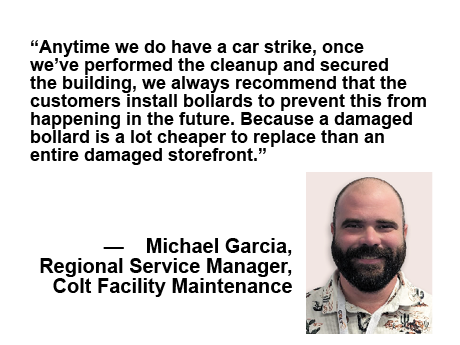By the time you finish reading this article, somewhere in the United States, a car will have run over the curb of a busy road, crossed the sidewalk and crashed into a retail space.
Colt
“There’s not a doubt in my mind that somebody is driving into a storefront right now,” says Jessica Suazo, regional service manager for Colt Facility Maintenance, based in Dallas.
Suazo’s company specializes in systems of bollards that protect buildings from these collisions. Also, for buildings not properly protected from collisions, companies like Colt provide emergency services. Colt technicians arrive at damaged buildings within hours, secure the site, prevent further damage and begin the process of cleaning up.
Prevention is the Best Cure
The best way to control the cost of a collision is to prevent it from happening. Many property owners protect buildings from automobile damage by installing barriers to stop wayward cars from getting too close. These barriers usually take the form of steel or concrete cylinders called bollards that rise a few feet out of the sidewalk.
Not every building needs bollards — some are much more likely than others to suffer these collisions. A building set in a fork in the road should consider some kind of protection, particularly if automobiles pass at more than 20 mph. In addition, many storefronts on busy main streets have cars parked perpendicularly or at an angle facing towards stores. Accidents in these places happen when a driver accidentally accelerates while parking, runs over the curb and hits the building. It would probably cost about $1,400 to install a 10-foot line of steel bollards drilled into the pavement — often enough to stop a car just beginning to accelerate.
A good rule of thumb is that if headlights shine into the windows of your building from less than 20 feet away, consider installing bollards. Restaurants and cafés with sidewalk seating or seating set in the roadway should also consider protective barriers, says Michael Garcia, regional service manager at Colt.
Owners or managers of buildings near fast-moving traffic might consider something more substantial. The cost to install a 10-foot line of concrete bollards reinforced with steel would start around $3,000.
Barriers that protect buildings from traffic come in all shapes and sizes. Some double as bike racks. Large concrete planters protect many important properties in Manhattan. Other bollards could be mistaken for geometric sculptures in bright colors. Even a line of simple steel posts can be styled to look like the old-fashioned hitching posts for horses that once lined many traditional main streets.
“The shop owner can choose to paint bollards themselves to suit the space,” explains Suazo. “A candy shop would be a great example — concrete bollards can be painted like a multicolored sweet.”
Cleaning Up After a Car Strike
If a car does strike a building, how can property owners limit the damage?
Often the first call a building owner or manager makes after such a collision is to their insurance company and their second call is to a facilities maintenance company like Colt. Colt’s customers include many owners and managers of retail properties, in addition to retail chains with many locations.
First responders such as police or firefighters often immediately respond to car accidents. But they won’t, for example, put house wrap over broken windows to stop moisture intrusion or build temporary walls to secure a damaged building.
Colt’s experts arrive at a damaged building within a few hours, depending on where the building is located. Colt has its own technicians in 20 states in the Southwest. Colt also serves customers throughout the rest of the United States through partnerships with other facilities maintenance companies.
For these technicians, the first priority is to prevent any more damage from occurring. Colt’s experts check the structural integrity of the building. They stop any water or gas leaks. “Our technicians are single minded,” says Garcia. “Their biggest concern is creating a safe area.”
Next, Colt’s technicians secure the site to prevent unauthorized entry overnight. They also begin the process of cleaning up the mess created by the crash. The team also removes any graffiti or other vandalism that the site may have attracted.
In one recent collision, a car struck an exterior column of a drugstore and proceeded through a plate glass window into the shop. Colt’s responders called an engineer to confirm that there was no structural damage, says Garcia. They removed loose framing and boarded up the shattered plate glass window, including a temporary doorway that could be locked with a padlock so that customers and staff could enter and leave the store. Colt also wrapped the broken column with house wrap to prevent any moisture infiltration. Finally, Colt’s team removed any debris and made a preliminary list of the materials that the building owner would need to fully repair the building.
“Anytime we do have a car strike, once we’ve performed the cleanup and secured the building, we always recommend that the customers install bollards to prevent this from happening in the future. Because a damaged bollard is a lot cheaper to replace than an entire damaged storefront,” says Garcia.
— By Bendix Anderson. Colt is a content partner of Retail & Restaurant Facility Business. For more articles from and news about Colt, click here.
